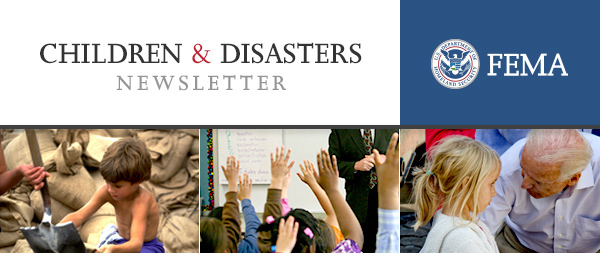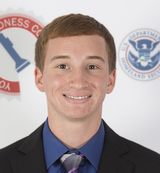DECEMBER 2015 - ISSUE 12
 The Student Tools for Emergency
Planning (STEP) program is a classroom-based emergency preparedness curriculum
for fourth- and fifth-graders in an easy, ready-to-teach format. Students will
learn about disasters, emergencies, and hazards, and how to create a disaster
supply kit and family emergency communication plan. STEP
lesson materials include:
Download the STEP curriculum at www.fema.gov/media-library/assets/documents/110946, and
watch the videos on FEMA’s
YouTube channel. You also can request copies of these free materials
from the FEMA Publications Warehouse by contacting FEMA-Youth-Preparedness@fema.dhs.gov.
|
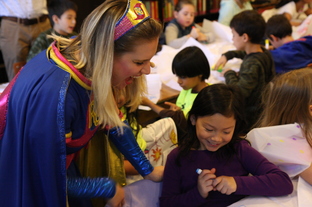 New York
City Emergency Management recently introduced Ready Girl, a superhero who
teaches young children about emergency preparedness. Ready Girl shows children
how to make family communication plans, identify emergency meeting places, and
make disaster supply kits. She also gives away coloring books and teaches kids
to make their own superhero costumes, so they can be superheroes just like her.
Ready Girl regularly makes appearances at schools, community events, and venues
throughout the city, and NYC Emergency Management aims to partner with other
preparedness organizations to reach thousands of children annually.
For
guides and other resources, or to request an event, visit the Ready Girl page
at the NYC Emergency Management website at: www1.nyc.gov/site/em/ready/ready-girl.page.
You can also read about Ready Girl’s adventures on her blog at: https://readygirlnyc.wordpress.com/.
|
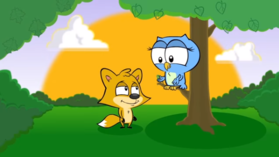 To
teach children how to stay safe and keep calm in an emergency, the Disaster and
Community Crisis Center at the University of Missouri developed an animated
video series, “Building Resilience with Hunter and Eve,” featuring Hunter the
fox and Eve the owl. In addition to the videos, there are supplemental
worksheets with answer keys, discussion guides for caregivers and teachers, and
coloring sheets. The series is designed for students in Kindergarten through
fifth grade. Watch the videos and download the supplemental materials at dcc.missouri.edu/hunter-eve.
|
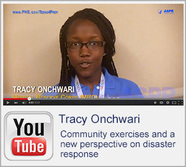 Teens across the country are helping their communities stay healthy during disasters and every day. Check out their stories and share your own on YouTube, Facebook, or Twitter using the hashtag #Teens4Prep.
Tracy
Onchwari, a volunteer with the Medical Reserve Corps (MRC), shared how exciting
a disaster exercise can be. Tracy joined an MRC disaster exercise complete with
dummies that sweat, bleed, and cry out for help. The experience has prepared her to help out if a disaster strikes her community.
|
 |
|
Another
teen volunteer with the MRC, Daniel Bosse Joseph, is dedicated to helping
improve health in his community so everyone can stay safe when a disaster
strikes. “I like helping out my community,” he said, “because it’s my home. I
like making sure that we’re all ready and prepared for any disaster that may
come, so we’ll all make it out strong.”
Find more
stories like these at: www.phe.gov/Preparedness/news/events/NPM2015/Teens4Prep/Pages/default.aspx.
|
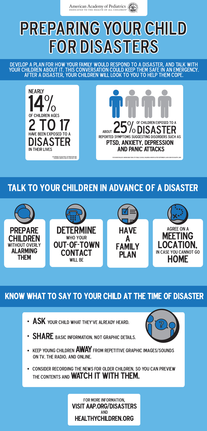 The unique needs of
children mandate specialized planning for disasters. Failing to address
children’s needs in advance of a disaster may put them in harm’s way, resulting
in morbidity and physical and emotional stress for them and their caregivers.
The newly released American Academy of Pediatrics' (AAP) policy statement, “Ensuring the Health of
Children in Disasters,” identifies
strategies for pediatricians and others involved in the care and well-being of
children to help them prepare for and mitigate the effects of disasters.
Disasters
can have short- and long-term impacts on a child’s physical and emotional
health and development. An updated AAP clinical report, “Providing Psychosocial
Support to Children and Families in the Aftermath of Disasters and Crises,” stresses
the importance of ensuring basic support services, psychological first aid, and
professional self-care while healthcare professionals and other child health
advocates are working with patients and families in the wake of disaster.
The AAP
also released a new infographic for families to help
prepare children for disasters. The infographic stresses the importance of
developing a plan and talking with children in advance of a disaster, as well
as identifies strategies that adults can use to help children cope.
For more information
about AAP disaster preparedness and response activities, visit www.aap.org/disasters or email DisasterReady@aap.org.
|
 Are you looking for an activity to bring parents, children,
and neighbors together? Do you need a
community building idea? Create your
neighborhood disaster plan! The City of Los Angeles has an innovative, simple, and
award-winning program that is designed to help local communities become more
resilient.
The 5 Steps to
Neighborhood Preparedness program was designed to give communities the
information and guidance needed to create disaster preparedness plans at the
neighborhood level.
|
 Here are the five steps:
1.
Define
your area.
2.
Recruit
leaders.
3.
Scout
your area.
4.
Build
your team.
5.
Plan
your approach.
These steps are easy to achieve, fun, and built to bring all
neighbors together, using trusted strategies like the Incident Command System and
incorporating programs like Community Emergency Response Teams.
Download the free toolkit, which includes a professionally
developed video and numerous resources in multiple languages, at: www.5Steps.LA.
|
|
To celebrate National Preparedness
Month in September, the Guam Office of Homeland Security and Civil Defense hosted
a preparedness video contest for high school students. Students were encouraged
to submit short digital videos that incorporated the theme “what does your
emergency plan look like?” and emphasized how families
can prepare for a disaster.
Congratuations to the five George
Washington High School seniors who won! You can
watch their video at https://www.youtube.com/watch?v=5CIfFjHROd0.
|
|
 |
In preparation for the holiday season, we asked FEMA’s Youth Preparedness Council members, if you could give one preparedness-related gift to your friends or family, what would it be?
|
“I would definitely gift
them with a Weather Radio. Chances are, most people already have the standard
items such as flashlights and extra water. However, a weather radio is just as
important because in an emergency such as a power outage, a radio can be the
best place to get local news or live updates on the situation. Bonus points for
a wind-up radio, which doesn't run out of power!”—Bridget Smith, Region I
|
|
|
|
“A simple emergency kit is the perfect gift. It can be a multitude of
gifts in one which can include a first aid kit, non-perishable food items, and
enough water for three days.” —Austin Witt, Region VII
|
|
|
 Youth Prepraredness Council
member Divakar Saini, Region IX, offers advice to stay safe in an emergency and the
following four steps even busy people can take to prepare.
Step 1: Make a kit. An
emergency kit provides basic survival items and enough essential provisions for
you and your family to survive for 72 hours without external assistance.
Step 2: Make a plan. During an
emergency, having a plan in place will help unite family members if they are
apart.
Step 3: Be informed. Look for information from your
local office of emergency management, and sign up to receive emergency alerts
on your phone and through email.
Step 4: Connect with your
neighbors. In an emergency, your neighbors are often the ones who you first
encounter and who can help respond. Take the time to discuss emergency plans
with one another.
For details, see www.paloaltoonline.com/news/2015/09/24/gunn-high-school-student-saini-promotes-national-preparedness-month.
|
Email: FEMA-Youth-Preparedness@fema.dhs.gov
Online: www.ready.gov/youth-preparedness
|








